Top 9 Rice Rangoli Designs | Styles At Life
A traditional rangoli is made of a wide array of materials such as kolam powder, gulal, fuller’s earth etc. However, if ease of procurement of the materials is desired, what better than the humble rice? Rangoli designs with rice range from semi-permanent to temporary rangolis.
Beautiful Rangoli Designs with Rice:
Stated below are some of the best rangoli patterns with rice.
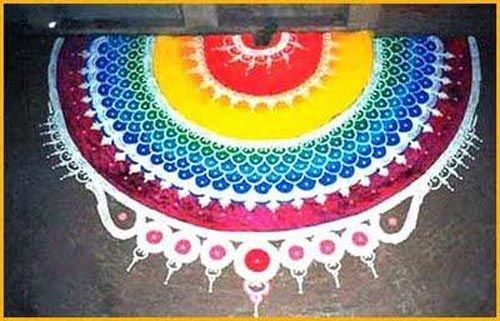
This is the most ideal pattern for the entrance of the house. The gradually outward moving concentric circles symbolize the positive vibe emanating from the home itself. The empty spaces between the concentric circles have been filled with warm and cool colours alternately. The rims and the spaces between them have been intricately designed to have miniature patterns. On the outer semi-circle, smaller circles have been placed which give the Rangoli design a directional feature.
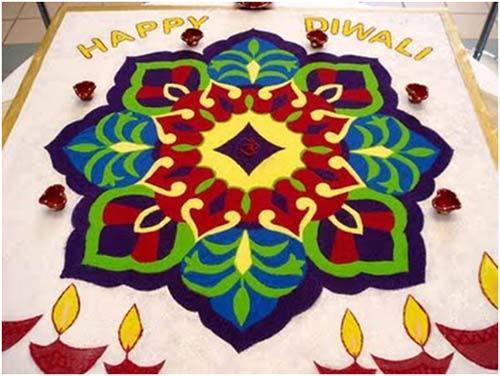
This is an example of a floral rangoli pattern. The design has been created exclusively for the occasion of diwali. A double layered thick petal is entirely filled with coloured rice mainly blue and violet. On top of this, a simple design has been presented. The center contains the symbol Om. This design is ideally suited for the center of a room.
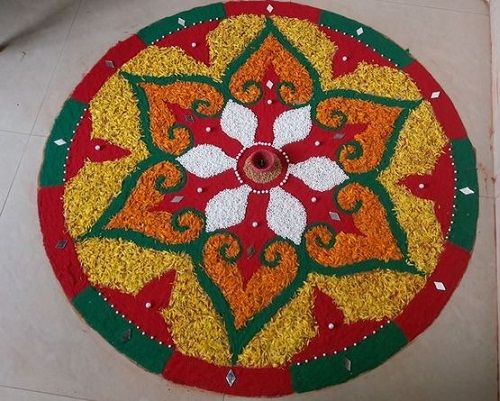
This floral design implements coloured rice and husks. With a central diya, the charm of the design is bolstered by using small cut mirrors and pearls.
See More: Rangoli Designs On Floor

This is perhaps the most simplistic design of a rangoli with rice in terms of decoration. However the design itself is quite intricate. This design is popular by the name of Alpana. It is mostly popular in West Bengal and is entirely made with the help of rice powder. Essentially a floral pattern, the feet in the center of the pattern symbolizes the feet of goddess Lakshmi as Alpana is mostly popular during Lakshmi puja in West Bengal. This type of rangoli with rice is a symbol of purity and austerity.

Essentially a spiral design, the rims of the spiral are coloured in transition with a darker hue at the outer section and a progressively lighter tone towards the center of the design. The large central circle contains the intersection eight squares coloured alternately yellow and orange. This is a typical example of Kolam, widely popular in South India during Pongal and Onam.
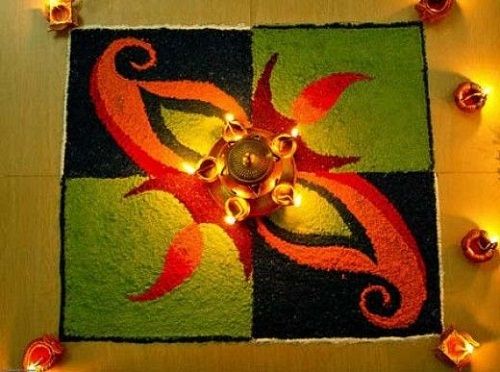
Unlike the previous rangolis with rice, this design implements a square base. The use of colours has been limited to a few bold ones. Together with coloured rice, Gulal has been used to create a matte finish. At the centre lies an ornamental pot, embellished by small sized Diyas. Four diyas adorn the four corners of the square symbolizing the spread of light in four directions.
See More: Rangoli Art Materials
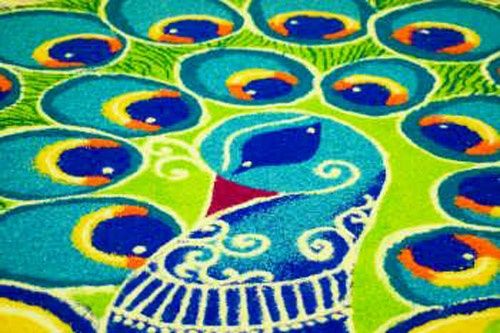
Visually, peacocks have the most colourful feathers among birds. It is due to this reason that this Rangoli celebrates the spirit of festivity with the theme of a Peacock. This Rangoli utilizes the seven basic coloured rice to bring alive the theme. This design needs spacing of colours with greater precision due to the usage of multiple shades of Coloured rice.

Perhaps the most intricate among these designs, this rangoli with rice requires a large area and a group of people to create the design. Four blade like structures emanate from a central circular pattern containing exquisite designing. This design is ideally suited for for places with a large gathering of people.

This design is best suited for a cultural programme as is evident from the theme. A Woman performing a traditional dance justifies the theme.
See More: Geometrical Shape Rangoli
Each design of rice based Rangoli is unique in the sense that it signifies the occasion more than just being a piece of art. However, in a true sense it vividly upholds the traditional sanctity of India.
images sources: 1, 2, 3, 4, 5, 6, 7, 8, 9.
28.06.2024 @ 13:40
Fantastic article! Your perspective on this topic is truly insightful. For those looking to explore this further, I found an excellent resource that complements your points: READ MORE. I’m eager to hear what others think about this!